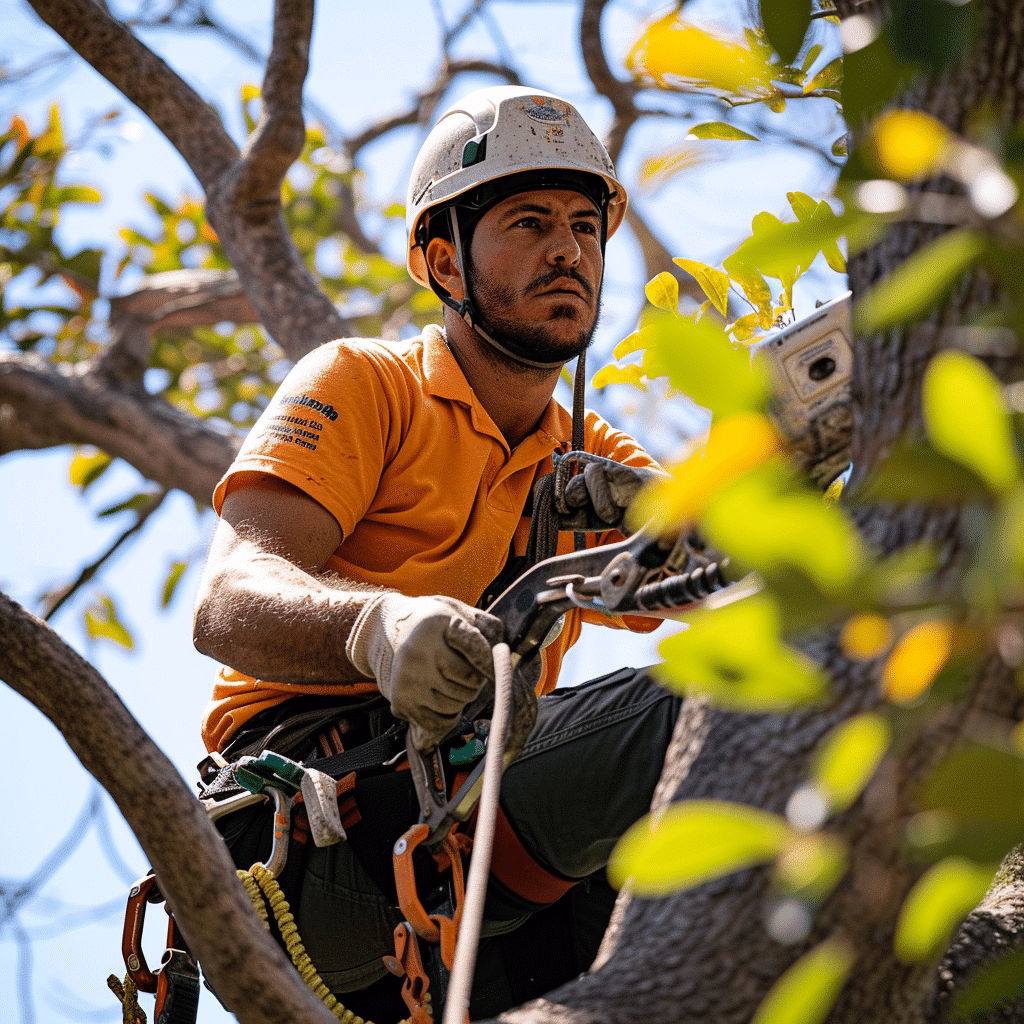By: Shelby McCullough| Published: February 16, 2024
Tree trimming combines utility with safety, emphasizing the need for strict adherence to tree trimming safety protocols due to the risks of working at heights, using sharp tools, and avoiding electrical hazards. Ensuring safety while trimming, especially near power lines or when handling large branches, is crucial. Following safety guidelines protects both the trees and the surrounding community, allowing for the preservation of natural wonders while maintaining a safe environment for all involved.

Key Takeaways
- Tree trimming is a high-risk activity requiring careful adherence to safety protocols.
- Working near power lines or with large or dead branches demands extra caution.
- Safety guidelines are essential not just for industry professionals but also for homeowners.
- Tree trimming safety protocols should ideally be done under favorable weather conditions—late fall or early winter for deciduous trees and late winter for evergreens.
- Before trimming or removal, a thorough inspection of the tree and surrounding areas is necessary to check for potential hazards.
- Ensuring all tools and safety equipment are in good condition is crucial for maintaining safety during tree trimming.
Understanding the Hazards of Tree Trimming
The process of tree trimming appears routine and straightforward, however, it’s host to many underlying dangers that pose serious threat to workers. These risks range from dizzying heights to slippery surfaces and sharp tools.
Common Risks and Consequences
Being a tree care worker is no easy job, confronting risks such as heights, slippery surfaces, sharp tools, and close proximity to electrical wires. Inadequate responses to these hazards can result in severe injuries or even fatalities. Notably, this industry has recorded one of the highest rates of reported injuries, which attests to its dangerous nature. Hence, there is an urgent need for tree trimming safety protocols, the importance of which cannot be overstated.
Key Responsibilities in the Tree Trimming Industry
It is extremely important that both employers and employees play their part in ensuring a safe work environment. These responsibilities include taking precautions and safety measures like inspecting equipment before use, maintaining open communication during operations, marking work areas, and keeping a safe distance from power lines. Meanwhile, employees are personally responsible for their safety through practices like consistently using personal protective equipment (PPE), taking care of their tools, and staying hydrated while working. An integral part of maintaining safe tree-trimming practices is to recognize troublesome signs, such as heat-related illnesses, and voice out safety concerns when they appear.

Assessing and Planning for Safety
No matter how experienced a tree care worker is in their job, they can not afford to forego the initial steps of safety planning. A comprehensive and thought-out safety plan is essential before starting any trimming work. This includes a daily on-site survey to identify risks and foster safety compliance. In addition, a proper tree-trimming safety precautions plan will help create a manageable and structured work environment, drastically reducing the risks of injuries.
Tree Trimming Safety Protocols
When it comes to tree trimming, safety should always be the #1 priority. From selecting the right tree-trimming safety equipment to adhering to a strict tree-trimming safety checklist, this industry requires careful consideration of the best practices and protocols. Here, we delve deeper into the most effective safety measures for arborists.

Essential Safety Equipment for Arborists
It’s all about protection when selecting the right gear. Starting with the basics: hard hats, sturdy, non-slip boots, and gloves. Added to that, the climbing gear and protective clothing such as leg guards become essential in reducing the chances of injury from falling debris or slips. Cheryl Conway, a senior safety analyst for Arborist SafeWork, emphasizes the need for face shields, safety glasses for eye protection, and hearing protection when using chainsaws. “It’s important not only to protect against immediate damage but also to prevent long-term hearing or vision loss,” she disclosed. Therefore, regular maintenance and optimization of ropes, harnesses, and climbing gear become crucial to this operation.
Professional Training and Preparedness
Tree trimming safety protocols isn’t just a physical job; it also requires mental preparation and continued education. Professional training is a non-negotiable aspect of this industry. Workers need to harness skills in using tools, mastering climbing techniques, understanding fall protection measures, and even providing first aid. Trimming agencies like Safe Arbor Services deliver competent training programs, ensuring every person on the team is well-equipped to handle emergencies. An integral aspect of these programs includes emergency planning and having insulated tools handy to mitigate electrical risks.
Weather Considerations and Job Site Safety
Then there’s the job site and weather. Safety extends beyond personal gear and training—it also involves creating a secure environment to work in. Chalking out traffic diversions, setting up warning signs, and deploying necessary safety protocols are part of the drill. Special caution is taken post-natural disasters or while working around power lines, a common fixture in suburban neighborhoods. “Power lines must always be treated as energized until certified otherwise by a trained professional,” advises Laura Green from WeatherSafe Tree Care. With the right safety measures in place, tree trimming safety protocols can be a straightforward and hazard-free task.
FAQs
What are some basic tree-trimming safety protocols?
Basic safety protocols for tree trimming include using proper safety equipment, ensuring regular maintenance of tools, conducting daily job site surveys, maintaining open communication during projects, and keeping a safe distance from power lines. It’s also important that workers have professional training in climbing techniques, fall protection, and first aid.
What are common hazards in tree trimming?
Tree trimming safety protocols involve several hazards, such as falling from heights, getting caught by slippery surfaces, dealing with sharp tools, working near electrical wires, and handling heavy branches. Accidents can result in serious injuries or even fatalities.
What are the key responsibilities in the tree trimming industry to ensure safety?
Both employers and employees in the tree-trimming industry have defined roles to ensure safety. These include conducting equipment inspections, maintaining effective communication throughout the operation, marking work zones, and keeping a safe distance from power lines. Employees are also responsible for consistently using personal protective equipment (PPE), keeping their tools in good condition, and staying hydrated during work.
What precautions should be taken for safe tree-trimming practices?
Assessing and planning for safety are crucial parts of safe tree-trimming practices. This includes carrying out thorough inspections of both the tree and surrounding areas for potential hazards such as electrical lines, ensuring all tools and safety equipment are in good condition, and developing a comprehensive emergency plan. It’s also advisable to work in pairs when working near power lines and to avoid the use of alcohol or drugs.
What safety equipment is essential for tree trimming?
Essential safety equipment for tree trimming includes hard hats, sturdy, non-slip boots, gloves, climbing gear, protective leg clothing, safety glasses for eye protection, face shields for chainsaw operation, hearing protection, and insulated tools to minimize electrical risks.
How important is professional training for tree trimming safety?
Professional training is extremely crucial for tree trimming safety. This training should include not just how to use tools but also safe climbing techniques, fall protection methods, and first aid instruction to ensure competent emergency response.
What weather considerations are important for job site safety during tree trimming?
Weather plays a critical role in job site safety during tree trimming. Operations should ideally be conducted in good weather conditions. For deciduous trees, late fall or early winter is recommended. For evergreens, trimming is best performed in late winter. Moreover, the job site should be properly prepared for safety, with warning signs and traffic diversions. Special caution is required when working post-natural disasters and around power lines.

